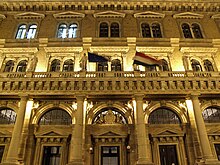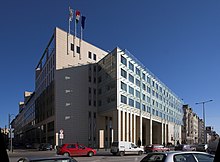Corvinus University of Budapest
This article has an unclear citation style. (August 2021) |
Budapesti Corvinus Egyetem[1] | |
 | |
| Motto | Scientia mea - Adiutor meus (My knowledge is my helper) |
|---|---|
| Type | Public university |
| Established | 1920 |
| Chancellor | Ákos Domahidi |
| President | Anthony Radev |
| Rector | Előd Takáts |
Administrative staff | 867 |
| Students | 11,500 |
| Location | Budapest , Hungary |
| Campus | Urban |
| Affiliations | Professional organisations: AACSB, AFANet, APSA, DRC, EAPAA, EUA, ECLAS, EFMD, ESA, IAU, ICA, IFLA, NISPA, PRME. Professional networks: ECA, CEEMAN, CEMS, EDAMBA, FFNet, LE NOTRE, MIRC, PIM |
| Website | www.uni-corvinus.hu |
Corvinus University of Budapest (Hungarian: Budapesti Corvinus Egyetem) is a university in Budapest, Hungary. Corvinus University of Budapest is a research university oriented towards education. The university currently has an enrollment of approximately 11,500 students, offering educational programmes in business administration, economics, and social sciences, operating in Budapest and Székesfehérvár since 1948.
Corvinus University accepts students at six faculties and offer courses leading to degrees at the bachelor, master and doctoral level in specialisations taught in Hungarian, English, French or German.
The University was listed in the top 50 in the Financial Times European Masters in Management rankings,[2] and was the first Hungarian university mentioned among the best in the area of agriculture.
Ministers of finance, chairmen of the National Bank of Hungary and prime ministers studied at Corvinus.
History[]
In 1846, József Industrial School opened its gates with departments for economics and trade for upper grade students. The immediate forerunner of the Corvinus University of Budapest, the Faculty of Economics of the Royal Hungarian University, was established in 1920. The faculty was an independent organization that was granted the same status as faculties of other universities.[3]
In 1934, the faculty was merged with other institutions including the University of Technology to form the Hungarian Royal Palatine Joseph University of Technology and Economics.[4] Modern economist training began in 1948, when the Hungarian University of Economics was established as a separate universitas.[5] Since then, the institution has undergone multiple name changes. In 1953 it was renamed Karl Marx University of Economic Sciences.[6] In 1990 the political system changed in Hungary. After 43 years democratic and free parliamentary elections were held. Following that the name of the university was changed to the University of Economics of Budapest.
In 2000, with the integration of the College of Public Administration, the institution was named Budapest University of Economic Sciences and Public Administration (BUESPA). The College of Public Administration was founded in 1977.[7]
In 2003, the three faculties of the former University of Horticulture (then part of the Szent István University) were integrated into the BUESPA. The first predecessor of the horticulture faculties, the School for practical Gardening (1853 - 1860) was the first institution of horticultural professional training in Hungary. The school was founded and managed by the horticultural scholar and publicist Dr (1805 - 1877), who was also a corresponding member of the Hungarian Academy of Sciences (HAS).[8] In 1939 an independent Royal Horticultural Academy was launched. It included three departments: agriculture, horticulture and landscape architecture. The latter was one of a kind in Hungary at the time.
In 2004, the university received its present name.[9] The name the Corvinus University of Budapest refers to the name of Corvinae (codices). Bibliotheca Corviniana was one of the most renowned libraries of the Renaissance world, established by the king Matthias Corvinus of Hungary.
The Faculty of Public Administration was appended[10] to the newly formed National University of Public Service[11] on January 1, 2012.
From 2013 Corvinus University of Budapest offered a Summer School program.[12]
In February 2019, the government announced that it would place Corvinus University under the newly created from July 2019. The foundation will be allocated 10% of the government's stake in MOL and Gedeon Richter worth HUF 380 billion at the time, with the operational expenses to be paid with the dividends from these companies. For all intents and purposes, the university will become independent of the government.[13]
Faculties and training programmes[]
At the Corvinus University, 11,500 students are enrolled in bachelor's, master's, single-cycle, postgraduate specialisation and doctoral programmes. Institutions

The teaching activities previously organised under the Faculties have been restructured for the 2019/20 academic year and have become institutionalised. Under the direction of the Institutes, training is divided into Departments.
- Institute of Economics and Public Policy
- Institute of Informatics
- Institute of Economics
- Institute of Communication and Sociology
- Institute of Marketing
- Institute of Mathematics and Statistical Modelling
- MNB Institute
- Institute of International, Political and Regional Studies
- Institute of Finance, Accounting and Business Law
- Institute of Business Economics
- Institute for the Development of Enterprises
- Institute of Management
Setting and architecture[]

The university is in an urban setting. The faculties operate in multiple buildings that stand in the city centre of Budapest.
The university's main building – now part of the UNESCO Heritage Site[14] – is located in Pest on the left bank of the Danube, next to the Great Market Hall and facing the Budapest University of Technology and Economics on the river's other bank. The main building was planned by Miklós Ybl as the Main Customs Office in Neo-Renaissance style. It was finished in 1874. The building was called "Vámház" (Customs House) and "Fővámpalota" (Chief Customs Palace). This is also the name of the nearby avenue. The building was connected to ports of the Danube by four tunnels. It had a railroad connection. During WW2 the Hungarian, German and Soviet troops used the building as a military base. The Customs House suffered serious damage during the war. In 1948 it became the main building of the University of Economics. It underwent major renovations in 1950 and later in 1989–1990.
Much of the education of the business faculties (Faculty of Business Administration, Economics, Social Sciences) takes place in the main building. This is the location of the rector's offices as well.

The university's Közraktár Street building was completed in 2007. It offers 50,000 square metres (540,000 sq ft) of floor space, which includes an office building and education areas. The building has community areas, and hosts the 450-seat central library of the university which contains 100,000 books and journals.[14][15]
Research[]
Corvinus is one of the most important[peacock term] research institutions in Hungary.
The Regional Centre for Energy Policy Research was established in 2004. The three main pillars of the Research Centre are education, research and consultancy. Their analysis focuses mainly on electricity and natural gas markets. They have been working on water management issues since 2007 and on transport issues since 2017.
In 2018, the Corvinus Institute for Advanced Studies (CIAS), an international research centre, was born to strengthen Corvinus' scientific performance and international embeddedness. There are more than 20 research centres operating besides them at the university.
Several research-related journals (Society and Economy, Vezetéstudomány [Management], Corvinus Journal of Sociology and Social Policy, Corvinus Journal of International Affairs, Köz-Gazdaság [Public Economy]) and publications (e.g. workshop series: Corvinus Economic Working Papers RePEc, Corvinus Law Papers) are published in the University.
Doctoral schools[]
At Corvinus University of Budapest, doctoral studies currently cover 7 fields of study:
- Doctoral School of Business and Management
- Doctoral School of Economics and Business Informatics
- Doctoral School of International Relations and Political Science
- Doctoral School of Sociology and Communication Science
The majority of courses are taught in English due to the growing internationalisation process based on an increasing number of foreign students.
Awards and places in rankings[]
This section needs additional citations for verification. (August 2021) |
In 2010, Corvinus won the Higher Education Quality Award in the Higher Education Institutions category. Its business majors are not only among the leading universities in Hungary, but are also internationally recognised: the University was ranked first in the region in 2019 by Eduniversal and second in 2020, and in 2019 it was ranked among the 100 best business schools in Europe by the Financial Times, while the University's Master's degree in Regional and Environmental Management was ranked 36th in the category of Sustainable Development and Environmental Management, also by Eduniversal.
Specialised colleges[]


The specialised colleges conduct in-depth research on a number of specialised subjects (e.g. social theory, finance, etc.), sometimes with the involvement of external academics or economic operators. Members usually live together on a separate floor of their university hall of residence or in a separate building. This promotes active community life and shared learning and research.[7]
The most significant of the university's specialised colleges in 2020 are:
- Rajk László College for Advanced Studies
- Széchenyi István College for Advanced Studies
- College for Advanced Studies in Social Theory (Társadalomelméleti Kollégium, TEK)
- EVK College for Advanced Studies
- Heller Farkas College for Advanced Studies
- Society of Young Autonomous Economists (FAKT)
- College for Advanced Studies of Diplomacy in Practice (GyDSz)
- Mathias Corvinus Collegium
- Szent Ignác Jesuit Specialised College
- Specialised College of Practical Diplomacy
Student organisations[]
In addition to the specialised colleges, Corvinus has more than 40 student organisations, making it the most active organised student life in the country. Some organisations have a professional focus, others are organised around a hobby, or internationalisation, etc.[8]
Notable alumni[]
- Sándor Csányi – Chairman of OTP Bank, owner of Bonafarm, investor, philanthropist, billionaire, the richest person in Hungary (according to Forbes)
- Bajnai Gordon – former Prime Minister of Hungary
- Sebastian Gorka – American military and intelligence analyst
- Surányi György – former Chairman of the National Bank of Hungary
- Fanny von Hann-Kende – physician and psychoanalyst
- Ákos Kovács – singer, one of the best-selling artists in Hungary
- Zoltán Kovács (born 1962), vice-president of the Hungarian Ice Hockey Federation and Paul Loicq Award recipient[16]
- Bokros Lajos – former Minister of Finance, Chairman of Budapest Stock Exchange
- Dávid Korányi – director at Atlantic Council
- József Váradi – CEO of Wizz Air
See also[]
Notes[]
References[]
- ^ "Corvinus University - Study in Hungary". En.study-hungary.com. Retrieved 2017-06-24.
- ^ "Archived copy". Archived from the original on 2008-05-14. Retrieved 2008-05-20.CS1 maint: archived copy as title (link)
- ^ "1920. évi XXXI. törvénycikk | 1000 év törvényei". 1000ev.hu. Archived from the original on 2017-07-25. Retrieved 2017-06-24.
- ^ "1934. évi X. törvénycikk | 1000 év törvényei". 1000ev.hu. Retrieved 2017-06-24.
- ^ "MT 2001/8 14". Matud.iif.hu. Retrieved 2017-06-24.
- ^ "Közgazdászképzés története". Uni-corvinus.hu. 2016-07-28. Retrieved 2017-06-24.
- ^ "Archived copy". Archived from the original on 2011-05-25. Retrieved 2009-01-02.CS1 maint: archived copy as title (link)
- ^ "Kertészettudományi Kar". Kerteszettudomany.uni-corvinus.hu. 2016-07-28. Retrieved 2017-06-24.
- ^ "A Karok története". Uni-corvinus.hu. 2016-07-28. Retrieved 2017-06-24.
- ^ [1][dead link]
- ^ "Uni-Nke | Uni-Nke". Uni-nke.hu. Retrieved 2017-06-24.
- ^ "Corvinus Summer School". Uni-corvinus.hu. Archived from the original on 2016-07-09. Retrieved 2017-06-24.
- ^ "Foundation with 10% stakes in MOL, Richter to fund Corvinus Uni". Budapest Business Journal. Retrieved 2019-02-11.
- ^ Jump up to: a b "Új épület a Corvinus Egyetemnek". Epiteszforum.hu. Retrieved 24 June 2017.
- ^ "Archived copy". Archived from the original on 2012-07-30. Retrieved 2009-01-02.CS1 maint: archived copy as title (link)
- ^ Podnieks, Andrew (February 4, 2020). "Legends join IIHF Hall of Fame". International Ice Hockey Federation. Retrieved February 4, 2020.
External links[]
- Corvinus University of Budapest
- Business schools in Hungary
- Educational institutions established in 1920
- 1920 establishments in Hungary
- Universities of economics in Europe


